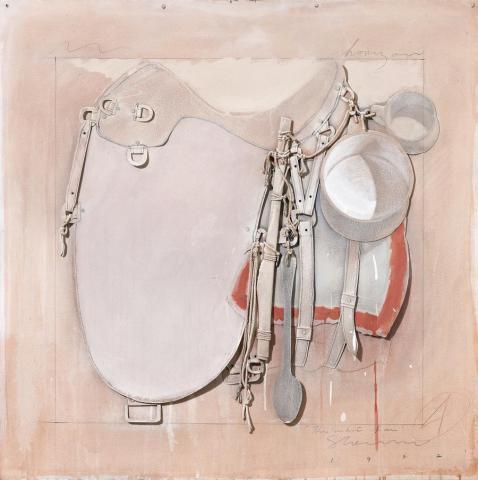THE WHITE PAN (SADDLE 4), 1982
TIM STORRIER
mixed media on paper
101.0 x 101.0 cm
signed, dated and titled lower right: 'The white pan’ / Storrier / 1982
inscribed upper right: horizon
Fischer Fine Art, London
Beryl Whiteley, Sydney
Private collection, Sydney
Grahame Sydney, New Zealand
Private collection, New Zealand
Tim Storrier, Fischer Fine Art, London, 24 February – 25 March 1983 (label attached verso)
Tim Storrier is posited in Australian art history as the quintessential painter traveller of contemporary art. Had he been born in the early nineteenth century he would have been an artist assigned to any number of the survey expeditions into the interior during the colonial era to chart the vast unexplored territory. As a contemporary artist he has commenced his own expeditions, both physical and psychological journeys, into the desert landscape of Australia and later North Africa and into his internal world as an artist and a man. In the early 1980s Storrier embarked upon a series of trips into the desert where he would construct three dimensional scenes against the mysterious horizon line and then spectacularly set them alight, documenting each scene as it burnt down to its final embers. It was here that the first series of burning ropes were conceived and later constructed as the Blaze Line paintings, which formed the core of his Burning of the Gifts exhibition at Australian Galleries in 1989. These were in effect relief paintings containing divers paraphernalia of the artist's campsite, such as bottles and bones, dangling from the burning ropes.
The White Pan (Saddle 4), 1982 was included in a group of very early saddle assemblages and shown in his first solo exhibition in London at Fischer Fine Art, where the reviewer commented that ''each tiny nucleus of possessions has the well worn, well cared for look that instantly suggests long periods of solitary, purposeful travel and is also a poignant comment on the frailty of man amid the immensity of nature.'1 The theme of the artist laden with not only his tools of trade but also with the burdens of his own past and that of art history itself has always resonated through Storrier's work. It found full expression in his 2012 Archibald Prize winning self portrait The Histrionic Wayfarer (after Bosch). Here the 'artist as wayfarer' is depicted in his desert landscape laden with an overwhelming surfeit of equipment including maps, compass, brushes, tent, canvas, paintbox, hat, telescope, funnel and dog. Like the saddle paintings it appears like a clever summation of the artist himself, faceless but ever present.
1. Philpotts, B., 'Saddle Provisions, Tools for the Primary Surveyor', in Arts Review, 18 March 1983
LARA NICHOLLS
